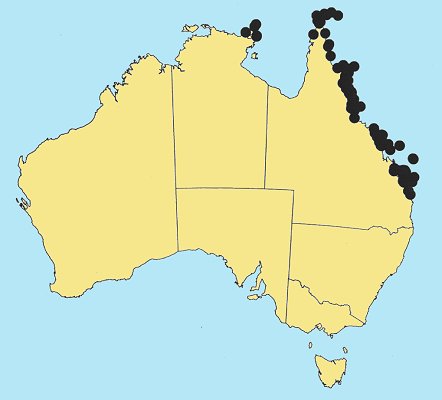Thuarea involuta (G. Forst.) R. Br.
ex Smith. Syst. Veg. 2: 808 (1817).
Classification. (GPWG 2001) : Subfamily
Panicoideae. Paniceae.
Basionym and/or
Replacement Name: Ischaemum
involutum G. Forst., Fl. Ins. Austr. 73 (1786).
Type of Basionym or Protologue Information: Societatis insule et passim intra
tropcios,.
Key references
(books and floras): [1810]. R.Brown, Prodromus (197 as T.
latifolia, T. media), [1878] G.Bentham, Flora Australiensis 7 (as T.
sarmentosa), [2002] D.Sharp & B.K.Simon, AusGrass, Grasses of
Australia.
Habit.
Perennial. Culms prostrate, 2.5–25 cm tall. Leaf-sheaths hairy. Ligule a fringe
of hairs, 0.5–1 mm long. Leaf-blades lanceolate, 1.5–7 cm long, 3–10 mm wide.
Leaf-blade surface indumented.
Inflorescence.
Inflorescence solid, a raceme. Racemes 1, erect, lanceolate, 1–3 cm long,
bearing 1(–2) fertile spikelets on each.
Spikelets.
Spikelets sessile. Apical sterile spikelets male (deciduous). Fertile spikelets
2-flowered, the lower floret barren (rarely male), the upper fertile,
comprising 1 basal sterile florets, comprising 1 fertile floret(s), without
rachilla extension, ovate, dorsally compressed, 4–5.4 mm long.
Glumes. Glumes
thinner than fertile lemma. Upper glume ovate, 4–5.4 mm long, membranous,
without keels, 5–7 -nerved. Upper glume surface indumented. Florets.
Basal sterile florets 1, male or barren, with palea. Lemma of lower sterile
floret 90 % of length of spikelet, membranous, 5–7 -nerved.
Fertile lemma 4–5.4 mm
long, without keel, 5 -nerved. Anthers 3.
Continental
Distribution: Africa, Temperate Asia, Tropical Asia, Australasia, and
Pacific.
Australian
Distribution: Northern Territory, Queensland, Cocos Keeling Is, Ashmore
Reef, Coral Sea Is.
Northern Territory:
Darwin & Gulf. Queensland: Cook, North Kennedy, Port Curtis, South
Kennedy, Wide Bay.
Notes. In
tropical heaths, tropical and subtropical rain forests, and coastal grasslands.
A widespread species restricted to sandy coastal areas where it forms extensive
stolons. Flowers Sept.-May. The upper spikelets of the secund raecme are male
whereas the lower 1–2 spikelets are bisexual or female. At maturity the upper
spikelets disatriculate and the axis bends to enclase the lower spikelets to
produce a nut-like structure which fall as a dispersal unit, which is able to
float and penetrate sand.
Thuarea is a
monotypic genus from the coastal regions of tropical Asia and Australia.


